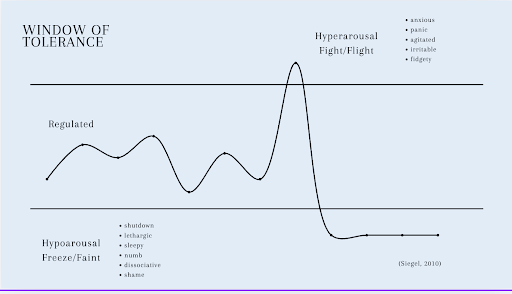Attending to Your Nervous System: Trauma Responses Versus Healthy Human Responses
You may be hearing terms like nervous system regulation quite a bit these days. More and more people are becoming trauma informed and seeking trauma informed therapy, which is fantastic but what does it all mean and how does trauma impact these systems? What is normal nervous system activation versus a trauma response? What is the parasympathetic nervous system versus the sympathetic nervous system? What do women need to know about good nervous system health?
At Virago Wellness, our commitment to women’s mental health means making sure you are informed about important topics like trauma responses and nervous system regulation.
We are breaking it down for you in this issue of the blog.
Nervous system 101
We’ve all heard of fight or flight but what does this mean? Your nervous system is a complex neural network that connects your brain to your entire body and all major organs. It’s a fine tuned machine that predates even the reptilian brain. Have you ever been to the Body Worlds exhibits? I don’t recommend going after lunch but that exhibit really highlights the complexities of these systems. This is a tangible, physiological system that exists in your body like your blood vessels. It connects to your limbic system in the brain. When activated, Dr. Daniel Siegel refers to this as “going limbic”. This system will sacrifice accuracy for speed and mobilize your entire body to respond before you have a chance to think about it. It cannot tell the past from the present and it cannot tell the difference between watching a horror movie and living one in real life (Recommended Reading).
Who’s ever seen a newly walking baby about to come near a dangerous object or situation and suddenly channeled their inner Wonder Woman to ensure that baby’s safety? There are two major branches of the nervous system: the sympathetic and parasympathetic branches. This system functions on its own but can be severely impacted by traumatic experiences. Not just major events like war or a car accident, but those lower level chronic traumas too. [What Is Trauma? Understanding the Types of Trauma That Impact Women Most]
Hyperarousal is the sympathetic nervous system response, all systems go and the body’s fight or flight responses activate. This is the system that kicked on to become Wonder Woman and save the teetering baby. This branch can go into overdrive causing panic, irritability or even anger and aggression. There is also hypoarousal or the parasympathetic nervous system, sometimes called the rest and digest branch of the nervous system. This helps us come back to baseline but it can also go into overdrive to the point of shutting the body down in the freeze and faint response. Some people will actually lose consciousness here (Recommended Reading).
Here’s a graphic that shows the ups and downs within your Window of Tolerance. Your WOT is your personal range of emotional or fight or flight activation that your system can “tolerate”. When something happens that is too intense, we get out of our window in either direction with the two branches of the nervous systems. The goal is to regulate or respond to the level of activation we are experiencing.
A brief primer of the nervous system
This is a very brief and simplified explanation of a complex system. A nervous system in good working order will reflexively respond to the emotional ups and downs of the day. Emotional ups and downs occur and you feel happy, sad, angry, frustrated, about the activities and events of the day. Something you experience in your environment alerts the system to activate, an appropriate level of activation occurs, and the system calms back down after. Let’s revisit the newly walking baby. The toddling baby nears the edge of a coffee table, you see this, without thinking your heart rate and breathing increase and your muscles get ready to respond. That may be happening even as you read this. Once the baby is safely headed towards the soft couch, your muscles relax, and your heart rate and respiration return to their normal baseline. You feel calm and safe and go about your day.
But for some of us, it’s not that simple.
What happens when we’ve experienced trauma? You may notice your fight or flight activation is highly sensitive and you feel anxious when there’s no need to be. Or you have a hard time calming down after being activated. You may also feel checked out, sluggish, disconnected due to dissociation. For someone who’s had real life experiences of extreme emotional activation due to major safety situations, or chronic minor ones such as an emotionally unresponsive parent or a high conflict family, the nervous system can get “stuck” in overdrive. It’s not overreacting, it’s a system that is stuck in the past. Again, we’ve “gone limbic”.
For folks who’ve experienced trauma in severe ways or in chronic ways, the nervous system can start to stay in chronic hyper or hypo- arousal. This is exhausting and takes quite a toll on our bodies and can seriously impact quality of life. Someone with a traumatized nervous system sees the toddling baby and immediately starts to worry about all the possible dangers. And if that baby does get a little bump? It could feel like life or death even when it’s not because a traumatized nervous system can get stuck in major responses because it can no longer detect the difference between ordinary events and life or death situations.
How does this affect women in particular?
One key way is that women are often taught to put the needs of others before themselves, to not be “selfish”, to be caring and considerate, and are often in care taker roles. For some this can lead to chronic experiences of self abandonment and neglect of personal needs. Women can inadvertently ignore their needs and signs of distress. This coupled with lived experiences of trauma and adversity is a perfect recipe for chronic nervous system issues. This may also be why women experience certain health issues like GI, chronic pain, and autoimmune challenges at such high rates.
How can therapy help?
The good news is the brain has a significant amount of plasticity and is capable of remarkable healing and so is your nervous system! Trauma Informed Therapy can help heal a traumatized nervous system by helping you reconnect to your body through mindfulness, self awareness and self compassion, learning how to prioritize yourself and no longer self sacrifice and self abandon. Therapy teaches women emotional literacy and emotional regulation. Talk therapy is a great start and EMDR, Eye Movement Desensitization Reprocessing is an evidence based therapy that gets to the core of these issues. EMDR targets the deep brain systems that talk therapy can’t reach in the same way.
You’re not broken, you’re just human
Remember, these are normal responses to abnormal experience and healing is possible. The key is to be gentle and compassionate with yourself, you deserve that. Our team of trauma informed therapists in Maine (and virtually for NY residents) are available to support you in whatever phase of healing you are in. Whether you are just getting started and learning about these complex systems or ready for the deep healing work of EMDR Intensives we are here for you every step of the way!


